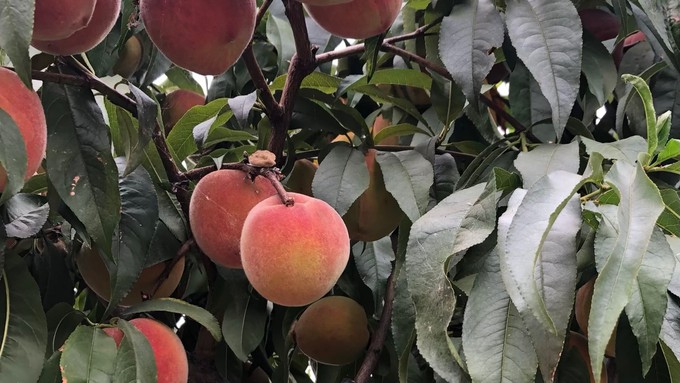
Learn about grafting and expand your orchard -- without growing new trees

If winter has you dreaming of peaches -- especially a new variety to graft onto an existing tree -- be sure to check out the Scion Exchange coming Feb. 26 in Carmichael. Kathy Morrison
Got fruit trees? Want more variety in your home orchard? Then, this fascinating and fun event is for you.
It’s the annual Scion Exchange (and it has nothing to do with old Toyotas). Hosted by the Sacramento Valley Chapter of California Rare Fruit Growers, the exchange is like a big community swap meet of fruiting wood. Scions are young shoots that can be grafted onto other trees or root stock.
Set for Sunday, Feb. 26, the exchange will be held at La Sierra Community Center, 5325 Engle Road, Carmichael. CRFG members get the first crack at selecting scions from 10 to 11 a.m. (and also sharing their own). Then, the exchange is open to the general public from 11 a.m. to 1 p.m.
Want to be an early bird? Anyone interested in joining the CRFG chapter can do so in advance of the event. Sign up here: https://crfg.org/home/join/.
For $5 admission, participants can select from dozens of varieties of deciduous fruit and nut trees from apples to walnuts. The assortment usually includes many heirloom varieties that are hard to find elsewhere.
Learn the basics of grafting, too, and how to add variety to your existing trees. Create a “fruit basket” tree with an assortment of plums, pluots and peaches on one trunk, or a “rainbow apple” tree that bears green, red and yellow fruit that ripens throughout the season instead of all at once. (Sorry, no citrus; just deciduous fruit and nuts are allowed at this exchange.)
What to bring? The organizers ask participants to bring exact change – $5 cash – and some supplies: Zippered plastic baggies (preferably 1 gallon size), masking or painter’s tape, a heavy marking pen (that way participants can label scions as they pick them up) plus a larger bag or backpack to put everything in.
Also, bring your wish list of varieties; you may be able to find them.
“We ask that you only take one or two scions from the varieties you want,” organizers say. “Be sure to wrap tape around those scions and label them! There will be a few vendors selling items and also tables with items that you can root: figs, berries, etc. There will be chairs available to sit but wear comfortable shoes to wander around the tables.”
Details: https://sacramentocrfg.org or email sacramento@crfg.org.
– Debbie Arrington
Comments
0 comments have been posted.Sacramento Digs Gardening to your inbox.
Sites We Like
Garden Checklist for week of April 21
This week there’s plenty to keep gardeners busy. With no rain in the immediate forecast, remember to irrigate any new transplants.
* Weed, weed, weed! Get them before they flower and go to seed.
* April is the last chance to plant citrus trees such as dwarf orange, lemon and kumquat. These trees also look good in landscaping and provide fresh fruit in winter.
* Smell orange blossoms? Feed citrus trees with a low dose of balanced fertilizer (such as 10-10-10) during bloom to help set fruit. Keep an eye out for ants.
* Apply slow-release fertilizer to the lawn.
* Thoroughly clean debris from the bottom of outdoor ponds or fountains.
* Spring brings a flush of rapid growth, and that means your garden is really hungry. Feed shrubs and trees with a slow-release fertilizer. Or mulch with a 1-inch layer of compost.
* Azaleas and camellias looking a little yellow? If leaves are turning yellow between the veins, give them a boost with chelated iron.
* Trim dead flowers but not leaves from spring-flowering bulbs such as daffodils and tulips. Those leaves gather energy to create next year's flowers. Also, give the bulbs a fertilizer boost after bloom.
* Pinch chrysanthemums back to 12 inches for fall flowers. Cut old stems to the ground.
* Mulch around plants to conserve moisture and control weeds.
* From seed, plant beans, beets, cantaloupes, carrots, corn, cucumbers, melons, radishes and squash.
* Plant onion sets.
* In the flower garden, plant seeds for asters, cosmos, celosia, marigolds, salvia, sunflowers and zinnias.
* Transplant petunias, zinnias, geraniums and other summer bloomers.
* Plant perennials and dahlia tubers for summer bloom.
* Mid to late April is about the last chance to plant summer bulbs, such as gladiolus and tuberous begonias.
* Transplant lettuce seedlings. Choose varieties that mature quickly such as loose leaf.